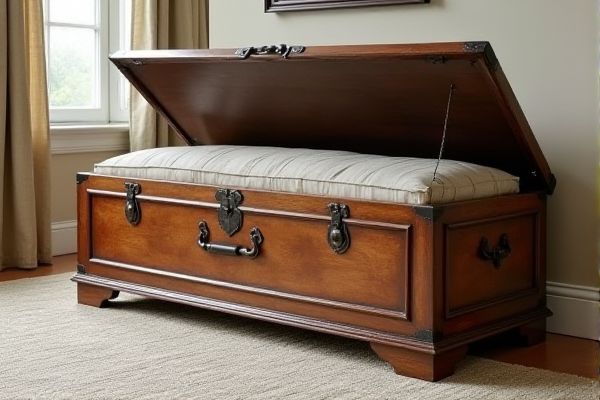
A chest bench offers comfortable seating and convenient storage, blending functionality with style, while a storage trunk primarily focuses on ample space for organizing your belongings with a sturdy design. Discover which option best suits your needs by exploring the detailed comparison in the rest of the article.
Table of Comparison
| Feature | Chest Bench | Storage Trunk |
|---|---|---|
| Primary Use | Seating and storage | Storage only |
| Design | Bench with cushioned top | Box with hinged lid |
| Storage Capacity | Moderate | High |
| Material | Wood, fabric, leather | Wood, metal, plastic |
| Portability | Moderate | Varies (often lighter) |
| Additional Features | Seating comfort, decorative | Lockable options, stackable |
| Ideal Location | Entryways, bedrooms, living rooms | Basements, closets, garages |
Chest Bench vs Storage Trunk: Key Differences
A chest bench combines seating functionality with storage, featuring a cushioned top ideal for bedrooms or entryways, while a storage trunk offers larger capacity primarily for storing bulky items like blankets or seasonal clothing. Your choice depends on whether you prioritize comfort and decor with a chest bench or maximum storage space with a storage trunk. Both options provide organizational benefits, but a chest bench often integrates seamlessly into living spaces as both furniture and storage.
Design and Aesthetics Comparison
Chest benches often feature upholstered cushions and sleek wooden or metal frames, blending comfort with stylish seating options for your living space. Storage trunks prioritize durability and rustic or vintage charm, frequently crafted from solid wood with metal accents to enhance their sturdy, functional appearance. Choosing between them depends on whether you prefer a versatile design that harmonizes with modern decor or a distinctive piece that adds character and practical storage to your room.
Functionality and Practical Uses
A chest bench serves dual purposes by providing comfortable seating along with internal storage, making it ideal for entryways, bedrooms, or living rooms where both comfort and organization are needed. Storage trunks primarily focus on maximizing space for storing bulky items like blankets, toys, or seasonal clothing, often lacking the ergonomic design for seating. Choosing between a chest bench and a storage trunk depends on whether the primary need is versatile seating combined with storage or purely efficient storage capacity.
Storage Capacity and Organization
A chest bench typically offers moderate storage capacity suitable for items like blankets, pillows, or shoes, often featuring a hinged top for easy access but limited internal organization options. Storage trunks provide larger capacity and often include compartments, dividers, or removable trays, enhancing the ability to organize various belongings more efficiently. The choice between the two depends on the need for capacity versus organizational features in a specific living space.
Material Options and Durability
Chest benches often feature hardwood, engineered wood, or upholstered options that balance aesthetic appeal with sturdiness, making them suitable for seating and storage. Storage trunks commonly use solid wood, metal, or reinforced plastic, prioritizing robust protection for stored items against wear and environmental factors. Durability in chest benches tends to depend on frame construction and upholstery quality, while storage trunks emphasize impact resistance and secure closures to safeguard contents.
Comfort and Multi-Purpose Use
A chest bench offers enhanced comfort with padded seating, making it ideal for your relaxation or as an extra spot in living areas, while a storage trunk prioritizes functionality with a sturdy, spacious interior perfect for organizing belongings. Both provide multi-purpose use; the chest bench blends seating with hidden storage, whereas the storage trunk emphasizes robust containment and can double as a coffee table or footrest. Choosing between them depends on whether your priority leans more towards comfortable seating or maximum storage capacity.
Placement: Where to Use Each
A chest bench works best in entryways or bedrooms, offering both seating and accessible storage for shoes, blankets, or accessories, maximizing utility in compact spaces. Storage trunks are ideal for living rooms or at the foot of beds, providing larger capacity for storing linens, toys, or seasonal items while serving as a decorative piece. Choosing placement depends on balancing daily accessibility needs with space aesthetics and functional storage requirements.
Maintenance and Care Tips
Chest benches require regular dusting and occasional polishing to maintain their wood finish, while storage trunks benefit from wiping down with a damp cloth to prevent dirt buildup. Keep both furniture pieces away from direct sunlight and moisture to avoid warping or fading. You can extend the life of your chest bench or storage trunk through proper care, such as using protective pads under heavy items and checking hinges or hardware for tightness.
Price Range and Budget Considerations
Chest benches typically range from $100 to $400, offering affordable seating with storage, while storage trunks vary widely, from $50 to over $500 depending on material and size. Your budget should consider not only the initial cost but also the durability and style that suits your space. Choosing between the two depends on whether you prioritize multifunctional furniture or straightforward storage solutions.
Which is Best for Your Space?
A chest bench combines seating and concealed storage, making it ideal for small spaces where functionality and comfort are priorities. Storage trunks offer larger capacity and can double as decorative pieces, perfect for rooms needing substantial storage without sacrificing style. Your choice depends on whether you prioritize versatile seating with storage or maximum space for bulky items.
 homyna.com
homyna.com